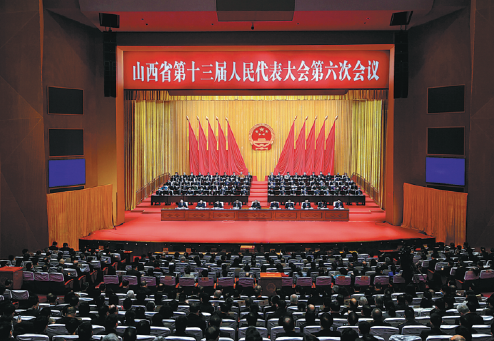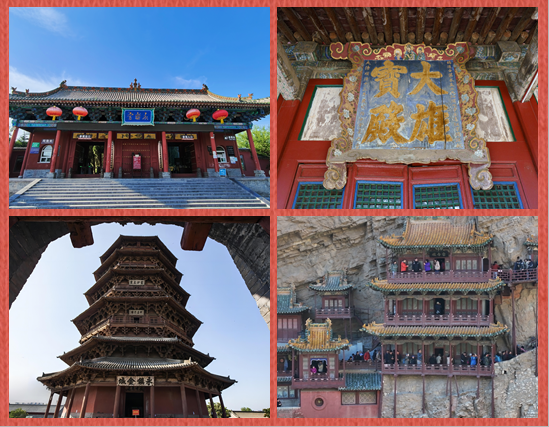Shanxi bounces back from COVID to break 2 trillion yuan barrier
Updated: 2022-01-29

The sixth session of the 13th Shanxi People's Congress is held in Taiyuan, capital of the province, from Jan 20-23. [Photo by Li Lianjun for China Daily]
Province's governor tells People's Congress and Political Consultative Conference of impressive GDP growth achieved over past 12 months
Shanxi's GDP surpassed the 2 trillion yuan ($316 billion) benchmark for the first time in 2021, according to Lan Fo'an, governor of this North China province.
Lan made the remarks at the sixth session of the 13th Shanxi People's Congress and the fifth session of the 12th Shanxi People's Political Consultative Conference, which were held concurrently in the provincial capital of Taiyuan on Jan 19-23.
On behalf of the provincial government, Lan delivered a government work report to more than 1,000 delegates and representatives of the two sessions.
In the report, the governor said that a record 2.26 trillion yuan GDP was achieved with a 9.1 percent year-on-year increase in 2021. Such a milestone development was driven by steady fixed asset investment, strong local market demand and rapid growth in international trade.
Lan said Shanxi's increases in fixed asset investment and consumer goods retail volume, which stood at 8.7 percent and 14.8 percent, were both higher than the national average.
In addition, the province's imports and exports represented an increase of 48.3 percent from 2020.
The governor said the achievements were made despite the COVID-19 pandemic, as a result of the province's effective measures in both virus prevention and control and stabilizing socioeconomic growth.
In addition to the increases, Shanxi has seen substantial improvement in the quality of economic operations.
In the past year, Shanxi made strides in an economic transformation strategy that reduces reliance on coal mining, upgrades traditional industries and fosters emerging industries as new growth engines.
According to Lan, the total investment made by Shanxi's enterprises in technological upgrades had increased 11.3 percent from 2020.
Traditional industries including coal mining, electricity, coking and steelmaking are using the latest technologies to upgrade their operations toward more advanced levels, leading to both improvements in efficiency and reduced emissions.
The coal mining industry, for instance, saw more than 75 percent of its capacities upgraded to an advanced level by the end of 2021.
In the electricity sector, Shanxi saw an increasing amount of power generated from new and renewable energy resources like solar, wind and natural gas. The power generation capacity from such resources reached 38.89 million kilowatts in 2021, accounting for 34.3 percent of the provincial total.
Lan said such a transformation in the electricity industry is in line with Shanxi's energy revolution strategy and the nation's long-term plan for peak carbon and neutrality.
In addition to trends in the energy industry, conservation practices in other industries led to a steady reduction in energy use. Lan said it looks set that Shanxi would meet its 2021 goal of reducing energy consumption per-unit of GDP by 3.2 percent.
When the Shanxi Provincial People's Congress session closed, it proposed 10 tasks for the government this year.
These include accelerating industrial transformation for high-quality development. In this area, the focus will be on improving the operational efficiency of traditional industries and fostering new growth engines by enhancing emerging industries, modern services, tourism and agricultural modernization.
Another mission for the government is to create a better business environment for all market players, especially private enterprises. The session asked for more proactive policies for the ease of doing business, like lowering the threshold for market access and helping enterprises reduce operational costs.
The Shanxi Provincial People's Congress session also suggested governments help to launch more projects relating to basic infrastructure, new infrastructure and the improvement of people's life quality to spur socioeconomic development.
It suggested continual efforts be made to promote urbanization for a balanced rural-urban development. A highlight this year is to develop an integrated economic zone between Taiyuan and the city of Xinzhou.
In the area of improving people's livelihoods, the congress proposed measures to promote professional skills training, offer more free healthcare services, further invest in education, have its social security system include more people, and invest in more grassroots cultural projects.
Other proposals from the congress session include measures to encourage innovation and entrepreneurship, boost environmental protection in the Yellow River drainage basin, reform State-owned enterprises and the financial system, and open wider to the world.
Guo Yanjie contributed to this story.



